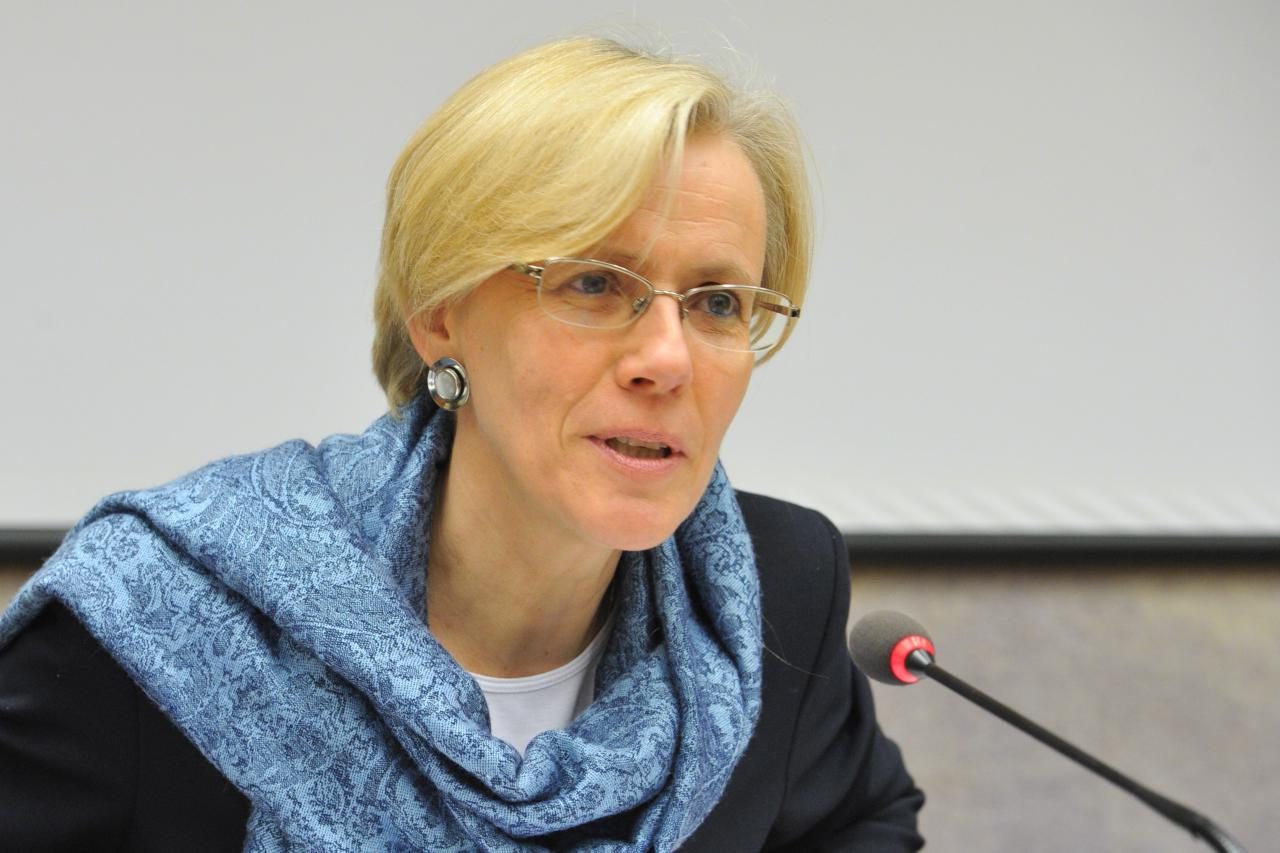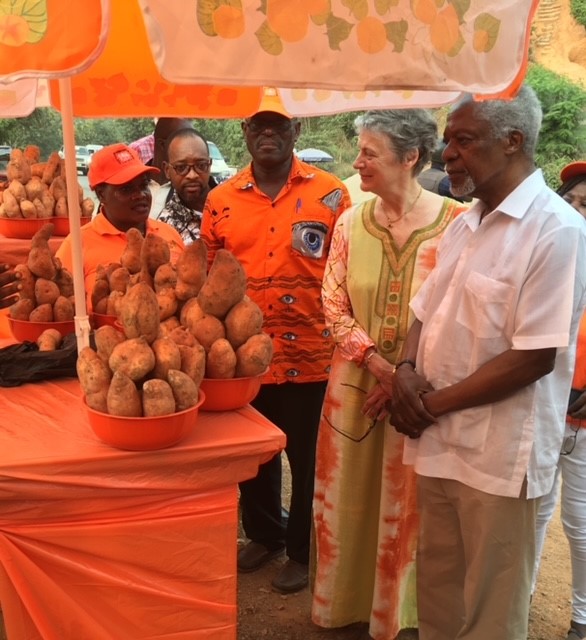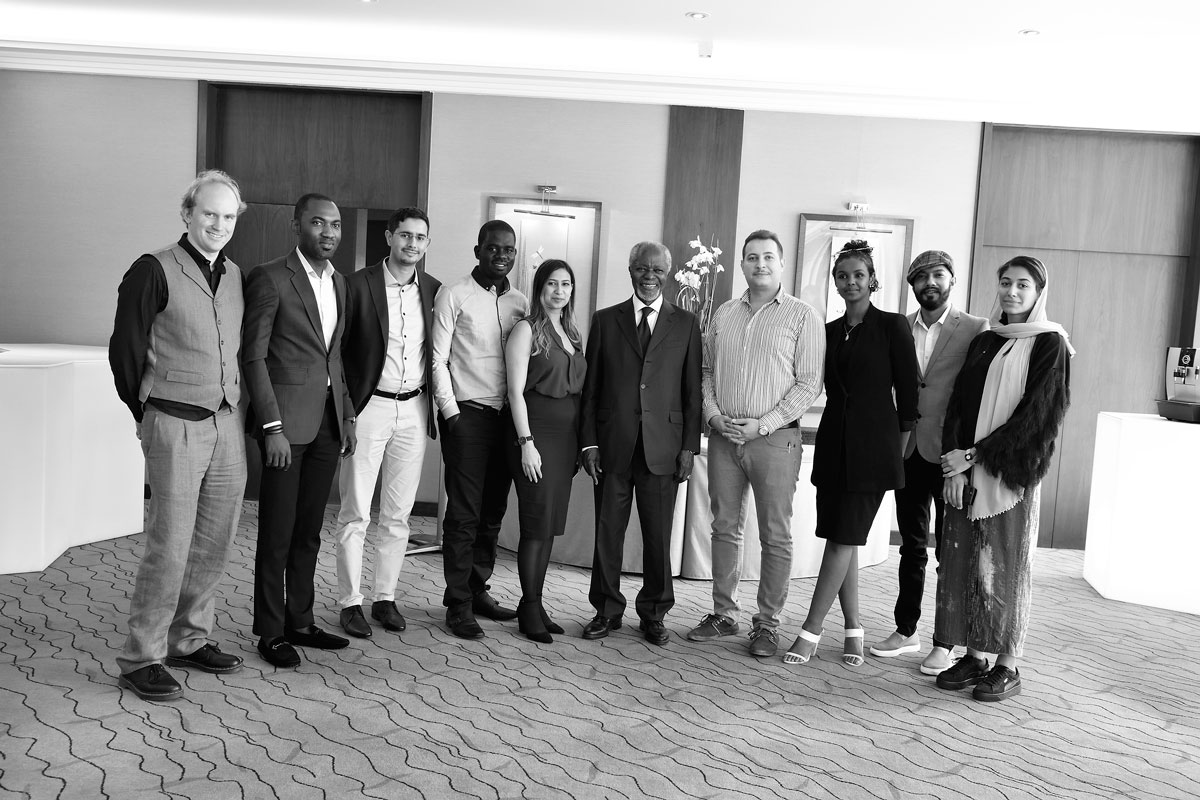Transforming Africa’s Role in the Global Food Security System
Let me begin by thanking Richard Dowden and my good friend Mark Malloch-Brown for inviting me to speak at the Royal Africa Society.Both are highly knowledgeable and committed friends of Africa. They could not have found a better berth for their talents.Throughout its long history, the Royal Africa Society has played a key role in strengthening links and understanding between Britain and Africa.
These links have, of course, changed as Britain’s relationship with the countries and peoples of the continent has evolved from colonial master to valued partner.
A new partnership underlined by the UK’s determination, despite these difficult financial times, to honour its obligation to support the world’s poorest.
This country can take pride that it will set a lead among the G8 in meeting the 0.7% target of GDP for development aid.
It is support which, as this distinguished audience knows, is still vital despite the new optimism and sense of expectation surrounding Africa.
There is no doubt that Africa is on the move. The continent is again rightly being seen as a place of opportunity.
Economic growth is strong. Countries and companies are queuing up to invest.
Increasingly the fruits of economic progress are being used to create jobs, raise incomes and to invest in the future – in education, in health and vital infrastructure.
But if African countries are to achieve the new future within their grasp, then there needs to be a new focus on the daunting obstacles still to be overcome.
High among these challenges is the need to transform the continent’s agriculture – the issue I want to address today.
This is a topic which, understandably, conjures up past failures, current frustrations, and, at times, overwhelming despair.
How could it not when there are some 240 million people in sub-Saharan Africa who do not eat well enough for their health and well-being.
But my argument today is that this profoundly depressing position is not set in stone.
I want to talk about how we can fundamentally alter Africa’s position within the global food system.
How, in fact, by working with Africa’s army of small-holder farmers, the continent can transform its agriculture to grow enough food to meet its own needs, and produce a surplus to meet growing demands across the globe.
As the UK’s authoritative “The Future of Food and Farming” report underlined earlier this year, such a transformation is necessary.
The planet’s population is forecast to grow from seven to nine billion in the next 40 years.
This would be a big enough challenge but coupled with an increase in prosperity in some parts of the world, it will put renewed pressure on food supplies and pose a new threat to the poor.
Together these two trends are forecast to see global demand for food grow by at least 50% over the next two decades alone.
Without a green revolution in Africa, without harnessing the massive agricultural potential within the continent, it is far from clear where and how this demand will be met.
So that is the challenge and opportunity ahead of us. But we have to begin with a brutally realistic appraisal of the poor performance of Africa’s agricultural sector.
The statistics are grim. Africa is the only one of the five continents which fails to grow enough food to feed its own citizens.
On average, cereal yields in Africa are a quarter of those of other major developing regions – and have barely increased in 30 years.
Per capita food production and agricultural labour productivity also remain remarkably low.
This is not because of a lack of effort by Africa’s farmers but a lack of knowledge, resources and infrastructure to support their hard work.
Only six per cent of Africa’s crop land is irrigated compared to 40 per cent in Asia.
African farmers use less than one tenth of the amount of fertilizer in Southeast Asia.
Instead they continue to rely on traditional ‘slash and burn’ and rain-fed farming that may have been adequate when populations were lower, but can’t meet increased demands for food.
The result is the severe degradation of land which keeps yields low and threatens its future sustainability and bio-diversity.
Africa’s farmers are also paying the price of the lack of investment by their own governments and the international community in agriculture and the rural economy.
Agriculture’s share of public spending in many African countries can be as little as half of what it is in their Asian counterparts.
Outside support for agriculture has collapsed with the proportion of development assistance falling from 18 per cent in the late seventies to just 3 per cent in recent years.
It is not just directly on crop yields that the effect of this investment shortfall in rural communities can be seen.
It can also be seen in poor storage and processing facilities which lead to increased waste.
It can be seen, too in poor road and rail links in rural areas which mean that Africa’s farmers face unusually high transport costs in exporting food or importing fertiliser.
There is an irony, too, that the peoples who have done least to cause climate change are the ones who are worst affected by its impact.
It is Africa, not the large emitters like America, Europe or now China, which the experts forecast will be hit hardest.
We are already seeing this impact in Africa as rains fail and previously fertile land turns into desert. It will further increase pressure on water resources and degrades bio-diversity.
But ladies and gentlemen, while this must be the start of our discussion, it is, as this audience knows, only half the story. For there is also unmatched potential within Africa for agricultural growth.
The continent is blessed with abundant land and natural resources.
Africa’s population is growing rapidly. But in comparison with India, for example, it has twelve times the land area and less than two thirds of its people.
Africa contains some 60% of the world’s uncultivated arable land.
And even Africa’s existing poor yields offers opportunities to make a huge difference.
If cereal yields were to be doubled to two tons per hectare – still half of the average in the developing world – Africa would grow an extra 100 million tons a year of food.
This would be roughly equivalent to adding another US corn belt to world food production, helping moderate world food price increases, shifting Africa to a major food surplus region and helping eradicate hunger and poverty.
And, of course, while rising food prices are bad news for poor consumers and set major challenges for governments, they also make investment in agriculture much more attractive.
So how can we achieve this transformation? How do we accelerate our efforts to harness Africa’s tremendous agricultural potential?
How, if you like, do we develop the continent’s own version of Asian’s Green Revolution which maximises the benefits and cuts out its disadvantages?
Africa is, of course, an incredibly diverse continent. There is no one size-fits-all strategy which can work. Priorities will be different and progress uneven.
But there are common factors for success and common obstacles which must be removed.
First, smallholder farmers are the mainstay of African agriculture and they must be at the heart of Africa’s green revolution.
Unfortunately much of the agricultural investment now taking place is by large scale private investors acquiring cropland for export production.
Large commercial farms do have a crucial role to play in developing Africa’s agricultural potential, particularly in land-abundant countries like Zambia and Angola.
Large farms can also serve as important hubs that link smallholders to value chains and help spread knowledge and best practice.
We need to foster these connections for the benefit of everyone.
So it is not a big versus small debate. But it a matter of accepting the reality of life in Africa.
Even today, four out of five Africans depend on farming and related activities to provide for their families.
It is why we need to put the emphasis on a genuine smallholder led green revolution.
This is not a new departure. There are already many successful examples of smallholder led agricultural development in Asia, such as Vietnam, as well as in many parts of Africa.
Investments in these strategies have paid off handsomely in terms of growth and poverty alleviation particularly when they are targeted at commercially viable rather than subsistence farms.
I understand this is a sensitive area. Subsistence-oriented farming is, of course, vital in feeding and employing poor people. We must maintain support for it.
But we also need to step up the funding and focus on commercially-viable small farms which have often been neglected.
For it is by unleashing the entrepreneurial spirit that will have the biggest impact on food supplies, on jobs and incomes in both the farm and rural non-farm economy.
This provides the motor – just as was seen in Asia – for wider economic development, for stability and prosperity.
But we will only work successfully through small-holder farmers if we lift the barriers they now face – by helping them harness scientific knowledge, by improving support and making markets work better.
We need to see the development and use of better crop varieties that can perform well with relatively low levels of external inputs, have good resistance to pests and diseases, are drought tolerant and have a high nutrition content.
Recent game changing successes such as drought resistant maize, TMS cassava and NERICA rice illustrate the impact they can have.
Yet we are seeing nowhere near the level needed of investment in R& D to meet specific African challenges or, crucially, helping African agriculture adapt to the growing threat of climate change.
In 2004 a study from the Inter-Academy Council of Africa concluded that spending on agricultural research needed to grow by at least 10 per cent per annum between 2005-2015.
In reality, agricultural R&D spending in Africa remains flat and among the lowest in the world.
Nor is the private research sector, which still invests relatively little in African agriculture, picking up the slack.
We urgently need to boost investment in African-led research into improved seeds but also to expand knowledge of the management of soil and water to protect the land and the continent’s bio-diversity.
In the short and medium term, most African farmers will continue to face the twin burdens of the high cost of fertilizer and lack of assured water supplies for irrigation.
So improvements will have to come mainly from better generation and use of plant nutrients and the better use and harvesting of seasonal rainfall.
This, of course sets us a further challenge – ensuring this shift towards more intensive farming technologies does not replicate the environmental and human health problems seen in Asia during the green revolution.
We can learn from more recent experience in Asia where the adoption of agro-ecological principles has reduced such problems with little, if any, loss in yields.
Improved research is fundamental to Africa’s agricultural transformation. But so is extension. Farmers must be supported to adopt the new technologies.
In Asia, research breakthroughs were complemented by government policies and investments which encouraged their successful uptake.
Yet in Africa, as we have seen, similar support has often declined.
We need to reverse this trend. But in Africa, it is likely to be private investment which will help drive the green revolution needed.
Indeed, if improved technologies are to spread quickly and widely, small holder farmers need affordable access to key inputs –seeds, other essential farm inputs and financial services.
Agricultural credit, in particular, is a major constraint for farmers and rural entrepreneurs.
Africa’s large and well capitalized commercial banks have proven very reluctant to lend to smallholders. We urgently need to change the equation.
Although still at a modest level, the Alliance for a Green Revolution in Africa (AGRA) – the organisation which I chair – has launched innovative ways to share risk with banks to boost lending for agriculture.
Partnering with the financial sector, AGRA has helped leverage $160 million in affordable loans to agriculture from commercial banks in Kenya, Uganda, Mozambique, Ghana and Tanzania.
In collaboration with AGRA, the Nigerian Government is also utilising $500 million through its Central bank to leverage as much as $3 billion in new lending from the commercial banks for farmers and the agricultural sector value chain.
We need to see the private sector recognise the advantages of investing in agriculture for them and their shareholders, as well the communities in which they operate.
Efficient and reliable markets, of course, can also help meet these needs.
In high value market chains, supermarkets, agro-processors and exporting firms often enter into contract arrangements with farmers and provide them with all their needed inputs and credit in return for an assured output.
But established markets for staple food crops are often missing, or under-developed, so this support is absent. AGRA and other organisations are working hard to fill the gap.
The lack of effective markets also means small-holder farmers can not rely on disposing of their crops at competitive and stable prices.
Fixing the market chains for food staples must be one of the highest priorities for Africa’s green revolution.
Making markets work better for smallholder farmers also means encouraging regional trade which is now held back by poor infrastructure and high transport costs.
Incredibly, less than 2% of Africa’s food staples production is traded between African countries.
Better infrastructure and market information systems and more open trade policies between African countries could lead to more stable prices for farmers and less hunger among consumers.
At the moment food supplies do not easily move from surplus to deficit regions, both reducing the prices paid to farmers and increasing their volatility.
It means a good rainfall leading to a bountiful harvest can cause local prices to collapse without meeting needs in areas which lack sufficient food.
At the same time, the international trading system must finally ensure effective and equitable market access policies so that African countries can compete globally on a level playing field.
This includes guarding against protectionist tendencies, which can be the knee- jerk reaction to rising prices, while providing protection for the agricultural sector in the poorest countries.
We need to see at the same time, as the other measures I have discussed, structural reforms – such as improved safety nets against price spikes – to protect the poorest of the poor from global shocks.
Priority must be given to stabilizing international supply and to moderating speculation in food and other basic commodities.
If global and regional food stocks were maintained at higher levels, it would help dampen the price volatility and speculation from which the poorest are suffering today.
There are other areas where we need urgent action.
There must be greater investment in human capital in rural areas, through improved schooling, business and vocational training, as well as programs to encourage young people into farming.
There is need to invest in building capacity and encouraging entrepreneurship across the entire market chain, not just in farming: in processing, providing credit, selling seeds and fertilizer, trading and retailing, and in exchanging technology.
Small-holder farmers need support to come together in an organised way, along with others in the agricultural chain, so their voices are more effective and their influence is greater.
And we need to see a bigger emphasis on helping women move from subsistence to more business-focused farming.
It is women, after all, who make up the majority of small-holder farmers.
Concerted efforts are needed to put women at the heart of policies to improve access to land, inputs, credit, technology, and markets.
Ladies and gentlemen, it is clear that the transformation I have described cannot be achieved overnight. The needs, however, are great now.
It is why efforts and resources must, I believe, be focussed first on those areas with the greatest potential to increase food supplies quickly.
This is the thinking behind AGRA’s innovative breadbaskets initiative which focuses on increasing yields and expanding cultivated land in fertile areas already endowed with a minimum of essential infrastructure.
Bringing governments, development partners, farmer organizations and the private sector together in an integrated way to invest in high potential areas will lead to faster and higher returns than investments in less favourable regions.
AGRA is already mobilizing partners to move the breadbasket approach forward in Ghana, Mali, Mozambique and Tanzania.
In the long-run, of course, success in these areas will lead to advances in agriculture across the continent.
But we have to accept that an initial focus on breadbasket areas may exacerbate regional inequalities.
It is vital to help countries mobilize additional resources to invest in less favoured areas so that these regions can, by adopting successful initiatives, catch up.
Ladies and gentlemen, as the UK’s Future of Food and Farming report concluded, the case for urgent action is compelling. And when it comes to achieving Africa’s potential I remain a stubborn optimist.
By supporting Africa’s farmers, we can take a major step to banishing hunger from the continent and helping future food needs across the world.
Such a uniquely African green revolution would also have a positive impact on many of the other challenges facing the continent.
It will, for example, reduce poverty, accelerate wider economic and social development, slow migration into Africa’s already over-crowded urban areas, boost women’s influence within their societies and provide new opportunities for business.
But to deliver all these benefits requires each of us to step up our efforts to deliver the transformation needed.
It needs greater political commitment by national governments and outside donors to a small farmer growth agenda.
We need increased resources, improved governance and policies to create a supportive economic environment.
We need to see renewed interest and investment by the private sector.
It will require scientists like the many here to work with your counterparts in Africa to fill the gaps in our knowledge.
And, of course, it needs expert policy groups like the Royal Africa Society to play your part in furthering understanding and forging partnerships to deliver these goals.
It is, I know, an ambitious agenda. But it is not a pipe-dream.
Somewhere in Africa the steps I have outlined are already delivering results whether in a research institute, perhaps partnered with a university here in the UK, or in a farm where new crops and techniques are dramatically improving yields.
I have seen myself just what is happening. It is why I am determined through AGRA to play my part.
We need to roll out these successes right across the continent, building on this knowledge and adapting it.
This is a challenge for all of us. For Governments within Africa and partners outside. For universities and research institutes. And for the private sector whose investment is vital to drive our continent’s green revolution.
With the right approach and collective effort, Africa will not only feed itself but can play an important role in shaping a truly secure global food system.
As I have said, the challenges are great. But the prize – a prize within our grasp – is even bigger.
Thank you.
[END]



